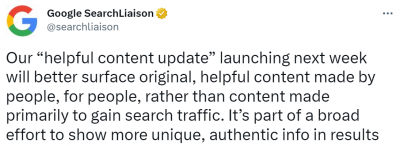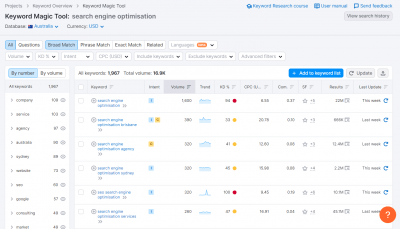How To Optimise Your Blog Post For SEO Like A Pro

Table of Contents
- What Is Blog Posting?
- Why Are Blog Posts Important For SEO?
- 4 Ways To Optimise Your Blog Post For Search Engines
- Plan Your Content With Refined Keyword Research
- Search For Semantic Keywords To Use For Your Focus Keyword
- Secure A Firm Position In The SERPs
- Incorporate Internal Linking In Your Blog Post
Do you want to gain an understanding of how to optimise your blog post for SEO?
When you optimise your posts for SEO, you are able to refine and boost your search engine rankings, giving you the ability to gain more traffic to your website.
Through this article, we will share with you our top tips that can assist you in optimising your blog posts for SEO like a pro.
What Is Blog Posting?
Blog posting refers to the use of technical and on-page SEO tactics in order to enhance your blog post’s visibility in organic search. When creating a blog post for SEO, there are two main objectives:
- To guarantee that search engines such as Google can find and understand your blog so that they can supply these posts to applicable searchers
- To ensure that you are creating blog content that is relevant and lines up with your audience’s wants, needs and interests
The tactics that are utilised to complete such a process are quite similar compared to those that are used to optimise the content on other sections of your website. Plus, if you are already an SEO specialist, these techniques will be very recognisable to you.
The primary difference between the two is that when you are creating a blog post, you are specifically incorporating search engine optimisation in order to sustain your current long-form content strategy. With this being said, you are essentially constructing content that is relevant, informative and aligns with your user’s needs and search objective. Plus, you may be utilising SEO techniques that you may already be familiar with to help your content succeed.

Why Are Blog Posts Important For SEO?
With every blog post that you write and optimise, you are able to:
- Boost your site’s visibility
- Prove your credibility and become a trusted source
- Gradually establish your website’s authority
If you wish for your website to be successful, you have to get your brand’s name out there and demonstrate that you are authentic and well-educated within your industry so that customers will know who you are. Luckily enough, blog posting can definitely help with that. Over time, as readers come across your content on search engines, you will start to become accepted as a reliable source, which will aid you in ranking higher.
Apart from blog posts being a way to gain organic traffic, blogs provide you with the ability to create fresh content and get rewarded for it. Search engines such as Google favour websites that are updated quite frequently. The more original and unique content that you publish within your blog posts, the more these search engines will revisit your website.
Google’s recent “helpful content update” has made it easier for people to find helpful and relevant content that is made by, and for, people. It ensures that content that is original and of high quality is guaranteed to rank highly in Search.

Therefore, due to Google’s new update, blog posting has never been more important. Users are more likely to come across search results that comprise of unique and authentic information, content that they have never seen before.
4 Ways To Optimise Your Blog Post For Search Engines
Plan Your Content With Refined Keyword Research
Many people who are just starting out with writing blog posts tend to guess article topics that they feel their audience would be interested in. You don’t need to rely on blind predictions, particularly when you can complete your own keyword research in order to find out specifically what your audience is searching for.
Keyword research is a tactic used by many content writers and SEO specialists that helps bring to light topics that your audience may be fascinated by based on search engine data. It is also a great way to construct an engaged audience.
It is recommended to use a keyword research tool such as SEMrush. This tool can allow you to gain insight into keyword data and provides you with competition analysis as well as keyword position tracking, and loads of other beneficial features.

Search For Semantic Keywords To Use For Your Focus Keyword
Once you have completed your keyword research, the next step is to select one main keyword that has the highest search volume. This will be your focus keyword. Your focus keyword is the search phrase that your audience will presumably use when searching for your blog.
You will then need to search for the Latent Semantic Indexing (LSI) keywords which are the searches that are connected to your focus keyword. As many of these keywords will need to be instilled within your content. Previously, an effortless way to find your LSI keywords would be to simply type out your focus keyword in Google Search and scroll down to the bottom of the page where they will be listed. Now, with one of Google’s new updates, it will be much easier to locate your LSI keywords.

Secure A Firm Position In The SERPs
Your readers are not clicking on your blog posts in search engines due to the impression that you made on them with your blog’s introduction. It is your post’s appearance in the SERPs where you have to make an amazing first impression. You may not have total control over how your blog appears in search results, but you can optimise your blog’s title and meta description.
To create a more effective blog post title, here are some key tips:
- Keep the title minimal: search results will only feature the first 50-60 characters.
- Ensure it is precise: your blog title should precisely match what the article is about. Incorporate strong descriptors to portray to the reader the type of content they will find.
- Keep it original: create new titles that are tailored for each blog post. Try not to reuse the same title across your site.
When it comes to the meta description, this is your opportunity to persuade your audience to click on your page. Here are some helpful techniques that you can incorporate to form an effective meta description:
- Ensure your character count only reaches up to 160 characters.
- Try searching for the keywords that you are trying to target yourself. See how other pages that are currently ranking have written their meta descriptions. Is there anything similar between them all? Use this research and insight to improve upon your own description.
Incorporate Internal Linking In Your Blog Post
A very successful way to enhance the time spent on your website and provide extra value to your readers is to incorporate links to other relevant pages on your site. The more time an individual spends on your blog post and website, the higher your page will rank in search engine results.
Place links on relevant keyword phrases rather than just placing links on a single word within your blog. For example, hyperlinking the phrase SEO Agency in Sydney would be more effective as compared to just linking the word “agency”, which would add no value at all. This anchor text is able to provide more context into what the reader will be expected to find when clicking on the link. Furthermore, ensure your links not only support your blog but are also beneficial and applicable to the reader.



